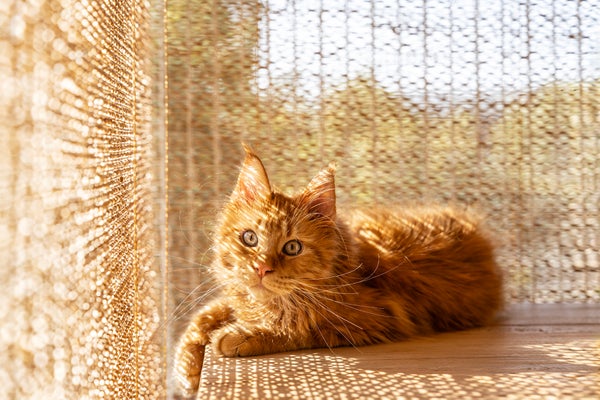August 19, 2024
6 min read
Bird Flu Is Infecting Pet Cats. Here’s What You Need to Know
As bird flu spreads in cats, cows and other animals, it has more opportunity to adapt to easily infect humans

For two and a half years, a deadly strain of avian influenza often referred to as H5N1 has been ravaging poultry farms. More than 100 million birds have been killed in the U.S., either by the disease or attempts to halt its spread. Wild birds have also been dying in enormous numbers. In late March scientists confirmed that H5N1 was sickening cows on U.S. dairy farms; nearly 200 herds in 13 states were affected as of August 15. Confirmed cases in people have been much scarcer: only 13 human cases were reported from April to August 9, and they have mostly involved mild illness, particularly characterized by pink eye. It is likely that infections in people have been missed, however.
Now the virus is being found in indoor pet cats. The Colorado Department of Public Health announced on August 9 that six cat infections in the state have been confirmed this year. Two of those detections were in samples collected in May, but at least three were in samples collected in July. What’s particularly worrying about the new announcement is that two of the infected cats were indoor animals. Scientists say this is a sign that the virus is widespread in animals and inching closer to touching the average American’s daily life.
“This identification of H5N1 in indoor-only cats is a big concern,” says Meghan Davis, an epidemiologist at the Johns Hopkins Bloomberg School of Public Health. “Increasing our surveillance and trying to understand the scope of this and get better messaging out is something I think we should be doing right now.”
On supporting science journalism
If you’re enjoying this article, consider supporting our award-winning journalism by subscribing. By purchasing a subscription you are helping to ensure the future of impactful stories about the discoveries and ideas shaping our world today.
These are not the first cats to be infected with the strain of avian influenza seen in dairy cows: at least 36 domestic cats nationwide have been reported to have the infection since March, including in the hard-hit states of Texas and Michigan. But some of the felines lived on dairy farms, plausibly roaming among infected cows and drinking milk chock-full of the virus. Outdoor cats can also get infected from birds or small animals they prey on.
For the new cases, there aren’t many details available, and it’s possible that even the indoor cats did spend time outdoors or that they consumed raw milk or meat from infected animals. But if not, the possibilities are concerning: these cats might have caught the virus from an infected mouse inside the home or perhaps even picked it up from a human with an unknown, asymptomatic infection from contact with other animals. Either of these scenarios suggests that bird flu is even more entrenched than we realized.
In Colorado the disease appears particularly pervasive: more than eight million commercial chickens to date have died because of the outbreak, more than 60 dairy herds have confirmed cases of avian influenza, and 10 human infections have also been confirmed. But epidemiologists say that doesn’t necessarily mean Colorado is more of a hotspot for the virus than other states. “They have really been taking it seriously, and I think they are highlighting to everyone else how much we may be missing,” says Seema Lakdawala, a molecular virologist at Emory University. “It’s not like, oh, everyone’s looking, and we’re only finding it here. It’s like, when you look, you find it.”
That means scientists are concerned about what they’re seeing in Colorado but also in what they’re not seeing across the nation. Bird flu is “probably more widespread than we appreciate, and it’s not just in these areas where there are concentrations of livestock or reports [of positive cases],” says Michelle Barron, an epidemiologist at the University of Colorado Denver.
If the first concern is the sheer quantity of avian influenza virus in the environment, the second is the number and variety of animals it is continuing to infect unchecked. Each new infection represents an opportunity for the dairy strain of the avian influenza virus to meet and mingle with whatever other flu viruses are present in the new host. Flu “viruses are notorious for developing mutations or taking genes from other viruses,” Barron says. “At what point is there risk that the virus changes and now makes people severely ill?”
Davis notes that pets are a particularly difficult population for epidemiologists to track because there are no state or federal regulatory agencies tasked with monitoring their health, as there are for humans and livestock, and because veterinary care can be an expense some owners can’t afford.
Pet owners who are concerned about bird flu should be aware of potential routes of exposure for their animals, Davis says. Don’t feed them raw milk or raw foods, whether commercially purchased or prepared at home. (Humans should also take raw milk, eggs and meat off their own menus. Pasteurization has been shown to kill the virus in milk, and cooking food kills most pathogens.) Cats with access to the outdoors are at risk, particularly during unsupervised time when they could be hunting infected animals. Domestic dogs have not yet been reported with avian influenza, but Davis warns that those who might interact with waterbirds may be at a higher risk of exposure to H5N1. Watch for changes in behavior that indicate a pet might be sick, especially a loss of appetite or trouble breathing, and consult your veterinarian if you’re concerned. In addition, people with pet ferrets should be particularly cautious because these animals are highly susceptible to influenza viruses and can develop serious infections.
Experts say the U.S. government and society at large need to start taking avian influenza seriously. “I think we are at an inflection point right now in the outbreak,” Lakdawala says. She wants to see a federal push for coordination among state agencies to increase surveillance and tamp down transmission between animals and into humans—efforts that, to date, have been primarily the responsibility of individual states.
Barron particularly worries that people’s emotional baggage from the COVID pandemic is stopping them from mounting a strong response to avian influenza. “I want people to understand that testing is good, having knowledge is good,” she says. She’s concerned that the trauma and politicization of the pandemic are fresh in people’s mind and that a desire to avoid repeating the experience may prevent people from facing the threat of avian influenza.
Right now the Centers for Disease Control and Prevention is emphasizing that for most people—excepting those who have direct contact with infected animals—avian influenza currently poses a very small threat. But the more the virus rages unchecked, the more likely that is to change. If bird flu was becoming more dangerous, one major signal would be a spate of human infections that were not connected with sick animals. That would indicate that the virus could jump directly between people. “I think that we’re only a short time away from actually seeing that, given how much virus there is in nature right now,” Lakdawala says.
And regular flu season is only a few months away, adding to the risks at play. There’s no evidence that annual vaccines for seasonal flu viruses can protect against bird flu, she notes. And if someone is simultaneously infected with both bird flu and seasonal flu, the worst parts of each virus could combine into a nightmare pathogen. “The worst-case scenario would be something that would be highly transmissible and severe in humans as well as in animals,” Davis says. The CDC has launched an effort to vaccinate farm workers with the seasonal flu shot to reduce the likelihood of this happening, but vaccines tailored to avian influenza have not yet been approved for distribution.
Even factoring in monitoring shortfalls, all three scientists emphasized that the dire scenarios they specialize in worrying about are not yet inevitable. “We have an opportunity now to work hard upfront so that we do not have a situation where we have to again be shutting down [society],” Lakdawala says. “Nobody wants an H5 pandemic. Nobody.”

